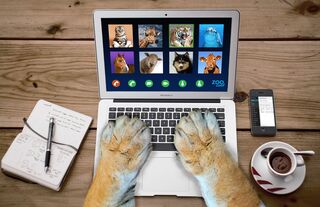My Team Has Drifted Apart During COVIDMarch 30 , 2022

How can I get them vibing again?
KEY POINTS
- Social connection—that feeling that we belong and that we are valued—is fundamental to individual flourishing and team effectiveness.
- Your goal is to create daily micro-moments of connection, not wait for rare, special-occasion events.
- Build social connection into daily routines and agendas with check-in questions, PechaKucha presentation, and creative use of technology.
Q: Like for most people, this pandemic has been hard on my team. We’ve been working remotely for 22 months now, and that’s not likely to change (which is fine with me in general). But we’re not as cohesive as we were pre-COVID, and I feel like we’re less productive, less creative, and have more tension and less fun together. How can I bring back that strong-team vibe?
 A: While working remotely has clear benefits— Comfortable pants! Less time commuting! Multi-tasking during meetings!—the lack of casual, daily human interactions between team members means many of our relationships have become transactional. We primarily see each other in “formal” settings with pre-set agendas and the social lubricant of “How was your weekend?” or “How about that [insert sports team] game?” conversations can get lost.
A: While working remotely has clear benefits— Comfortable pants! Less time commuting! Multi-tasking during meetings!—the lack of casual, daily human interactions between team members means many of our relationships have become transactional. We primarily see each other in “formal” settings with pre-set agendas and the social lubricant of “How was your weekend?” or “How about that [insert sports team] game?” conversations can get lost.
And social connection is critically important. That feeling that we belong, that we are valued, that others care about our welfare, and we care about theirs is as fundamental to our lives as water, food, and shelter.
Your goal is to create what Jane Dutton, a top relationships-at-work researcher from the University of Michigan, calls “high-quality connections.” These are those moments where people are in sync with each other, where they feel connected and heard, energized and enthusiastic about the conversation—what the teens in our house call “vibing.” These micro-moments of connection are essential to building trust and long-term relationships, which drive individual flourishing and team effectiveness.
But in a remote-work world, it doesn’t happen on its own. People often think of company picnics, birthday celebrations, and off-site retreats as their social connection toolkit. But if we only rely on these rare, special-occasion events, we’ll never build the kinds of relationships that drive real and meaningful engagement, happiness, and productivity.
As a manager, you have to be intentional about creating space for social connection.
The most effective tactic is to build social connection time into team and project agendas. We have a tendency on Zoom to jump right to work. Instead, set aside time on each agenda to explicitly connect with each other. That could look like a quick check-in question that can be answered in 30 seconds or less (note: you can split bigger teams into smaller breakout sessions). Your goal is to give them something to talk about after the meeting, not to have full conversations. Think get-to-know-each-other questions like “best book or movie you’ve seen/read recently,” “first job,” or “something you’re looking forward to this month.” Bonus: this tactic gets everyone speaking, so they are more likely to speak up in the “meat” of the meeting.
A fellow happiness speaker friend, Scott Crabtree, came up with a powerful three-minute tool to help team members connect. He based it on a Japanese style of presentation called a PechaKucha. Here are the basics: Each person pulls together 10 photos or images that represent important aspects of their life outside of work (just the photos, no text) and has 10-20 seconds to explain each image. You invite one person to present at the beginning of each meeting. The nice thing is 200 seconds isn’t long enough for complete stories, but you can get a good feel for someone from hearing their interests, and it generates all kinds of curiosity to learn more: “I didn’t know you were a beekeeper, do you get stung a lot?”; “I used to live in San Antonio, too. When were you there?”; “What kind of music do you play in your band?” Rotating through team members over time can unearth all kinds of opportunities for connection and mutual understanding.
Also, think about how you use your remote communication tools.
Slack or other instant message platforms are a great space to recreate the “how was your weekend?” conversations. Model using the chat feature in Zoom to have a more casual connecting time. Turn on video in meetings during social connection time because nonverbal communication helps the connection. Don’t make non-participation punitive; let people pass when they need or want to. Lean on those who are enthusiastic to normalize these activities, and others will follow.
It’s possible that you will get pushback from some team members that this isn’t “productive” time or from introverts who (incorrectly) think that social connection isn’t important to them. But remember that when Google set out to study what makes the strongest, most effective teams, they found that the individual traits of the members (intelligence, creativity, drive, etc.) didn’t matter. It was the social connections on the team—both whether the individuals prioritized social connection and if the team had an environment where everyone felt safe sharing ideas—that drove high performance and engagement. So re-brand social connection time as the most productive part of your time together.

